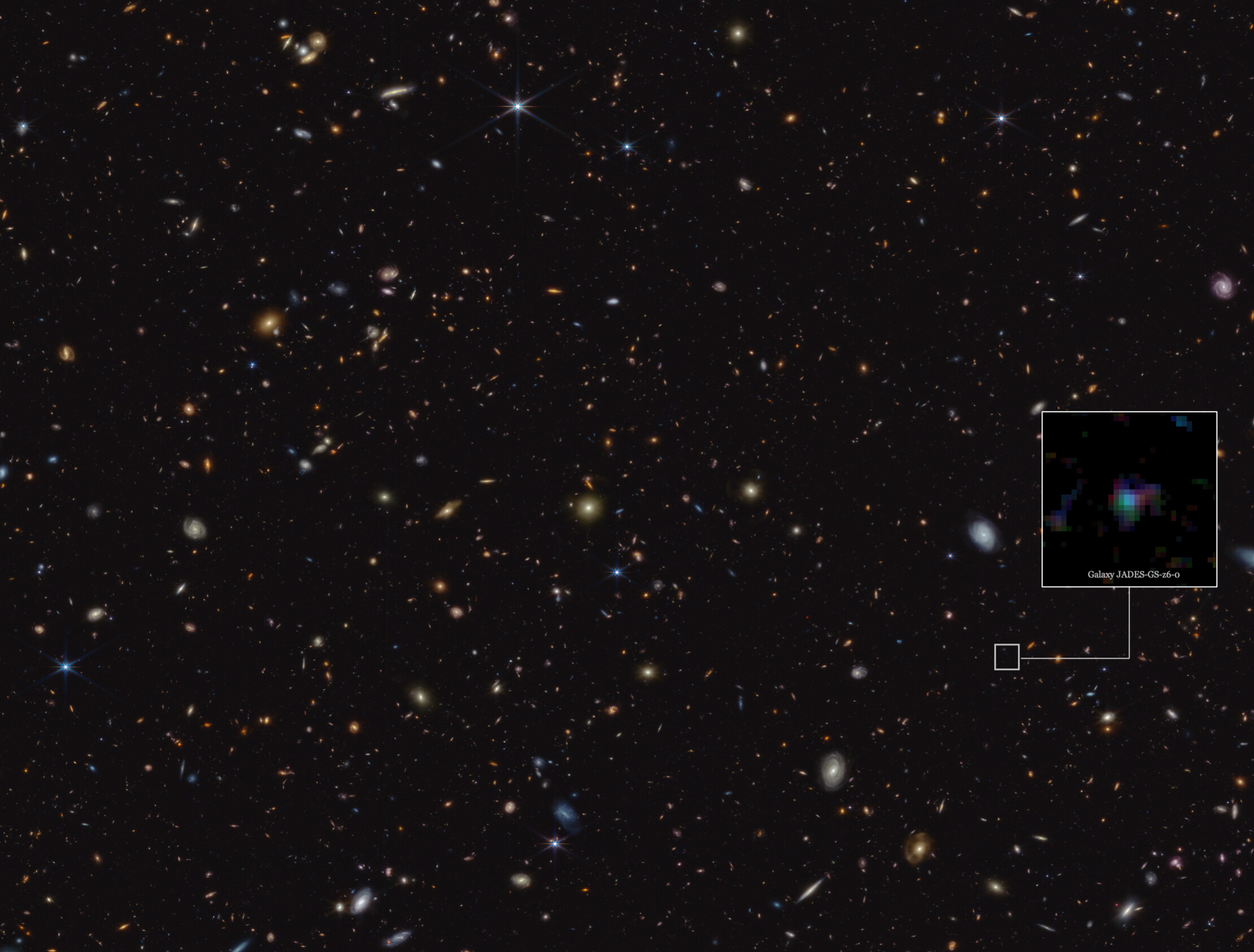News & Media highlights
JWST finds most distant known galaxy
With the discovery of the two most distant galaxies to date, JADES broke the previous distance record (from just one year earlier). These results were highlighted on the NASA website of JWST.
New measurements with JWST reveal the spectra of two record-breaking galaxies, the most distant of which is observed only two hundred and ninety million years after the big bang. To call this galaxy surprising would be an understatement: not only does it shatter the redshift record, but also all our expectations of what such early galaxies might look like. The analysis is presented in Carniani et al. (2024), Nature, 633, 318.
Image credit: NASA, ESA, CSA, STScI, B. Robertson (UC Santa Cruz), B. Johnson (CfA), S. Tacchella (Cambridge), P. Cargile (CfA).
JWST sees carbon-rich dust grains in the first billion years of cosmic time
In July 2023, JADES announced the discovery of the absorption signature of carbon-rich dust grains at redshift ~ 7 (Witstok et al. 2023, Nature, 621, 267). These results were highlighted in a press release on the ESA website of JWST:
Joris Witstok of the University of Cambridge, the lead author of this work, elaborates: “Carbon-rich dust grains can be particularly efficient at absorbing ultraviolet light with a wavelength around 217.5 nanometres, which for the first time we have directly observed in the spectra of very early galaxies.”
Image credit: ESA/Webb, NASA, ESA, CSA, B. Robertson (UC Santa Cruz), B. Johnson (Center for Astrophysics, Harvard & Smithsonian), S. Tacchella (University of Cambridge), M. Rieke (Univ. of Arizona), D. Eisenstein (Center for Astrophysics, Harvard & Smithsonian), A. Pagan (STScI), J. Witstok (University of Cambridge)
Read the full press release and listen to a radio interview here:
JWST reaches new milestone in quest for distant galaxies
In December 2022, JADES announced the discovery and subsequent spectroscopic confirmation of four of the most distant galaxies, including the two most distant galaxies to date. These results were highlighted on the ESA website of JWST. New measurements with JWST have discovered and unambiguously confirmed the most distant galaxies known to date, representing a major breakthrough in understanding our cosmic origins and promising a bright future for further discoveries with JWST.
Previously, the first imaging surveys taken by JWST had revealed candidate galaxies seen when the Universe was less than 2% of its current age. Identifying and characterising these distant galaxies is essential to our understanding of galaxy formation and, more broadly, of the Universe as a whole. Preliminary analyses have indicated the abundance of these candidates may violate prevailing cosmological models of galaxy formation. Without spectroscopic confirmation of their distances, however, these findings remain speculative. New results from the JADES collaboration have now confirmed the nature of four of the most distant galaxies, including the two most distant to date. The NIRSpec instrument was able to provide spectroscopic confirmation of four galaxies initially identified in one of the deepest NIRCam imaging survey so far (see figure on the left). The analysis is presented in two companion papers published in Nature Astronomy, Curtis-Lake & Carniani et al. 2023 and Robertson & Tacchella et al. 2023.
Image credit: NASA, ESA, CSA, M. Zamani (ESA/Webb), Leah Hustak (STScI), Brant Robertson (UC Santa Cruz), S. Tacchella (Cambridge), E. Curtis-Lake (UOH), S. Carniani (Scuola Normale Superiore), JADES Collaboration.


